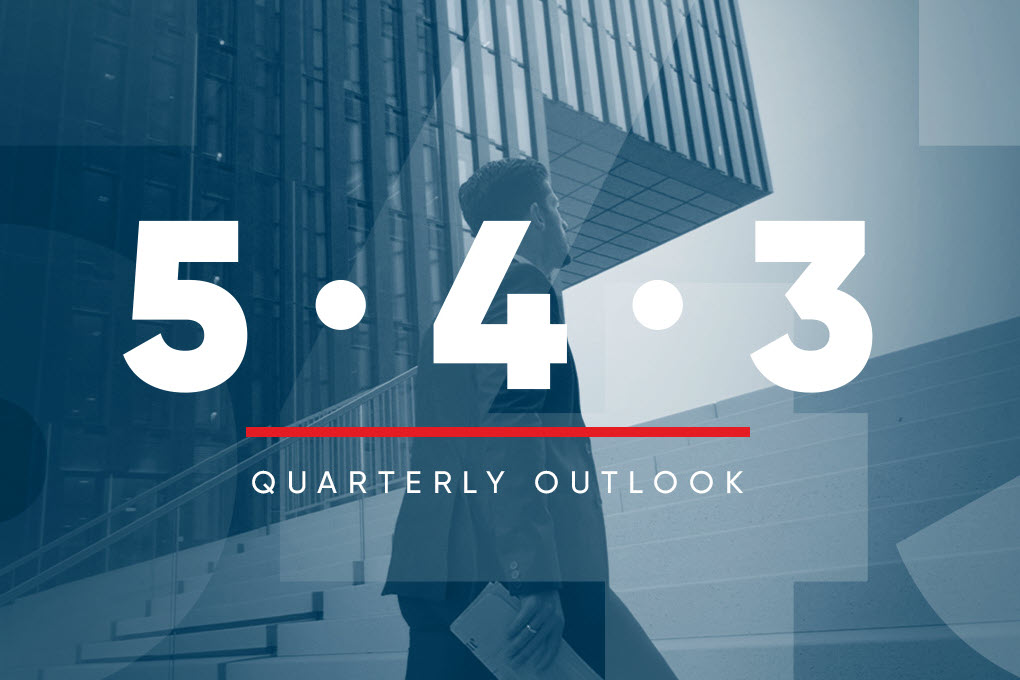5 • 4 • 3 | The winds are shifting

Although the tariff storm has fortunately not caused too much damage so far and the summer has been clement on the markets, sales are slowing down and the economy is going through a transition in the United States. What should investors think? In 5 minutes, our investment strategist Louis Lajoie explains why there is ground for optimism.
Hello everyone. Today, September 4, we're going to take a few minutes to look back on the key events that have happened over the summer months for the economy, for markets, as well as what this all likely implies for investors going forward.
Without further ado, we must say that we have enjoyed a remarkably clement summer on the financial markets with for instance equities remaining well anchored on an upward trend, now up by about 13% year to date and even almost 18% for Canadian equities, which continue to outperform, thanks notably to good returns on the part of the materials sector. But what really stands out from the last, the last few months is just how little volatility we saw across financial assets with bonds, for instance, still treading water, but also even on the currency front, which for the most part have essentially consolidated their recent moves or moves from earlier in the year in the case of the Canadian dollar, that's a gain against the U.S. dollar.
So quite a contrast with the extreme volatility from earlier in the year, a contrast that can be largely explained by the fact that the most severe fears that were stoked by the arrival of the U.S. economic agenda have simply not materialized into actual economic data. For instance, inflation continues to largely send the same signal message it was saying earlier before the arrival of tariffs, with for instance Canadian inflation around 2% and U.S. inflation higher, in their case around 3%. So that remains something to keep a close eye on.
But behind these figures, there seems to be a shift in the backdrop, an inflationary backdrop. When you ask U.S. small businesses what is your most important problem right now, you see that the answer is less so inflation as before and increasingly so poor sales that are becoming problematic. And that is an important change in the backdrop because the more sales top line growth is problematic, the more, the higher the chances that eventually that will result into layoffs. And that explains effectively the tight relationship between poor sales and the unemployment rate. So, we'll have to keep a very close eye on how the labour market will evolve over the coming months.
And, accordingly, how the U.S. Federal Reserve will adjust its policy stance against these changing conditions. We are already starting to see a bit of a change in tone, a change in guidance, with President Powell, for instance, saying that the balance of risks appears to be shifting, essentially opening the door to rate cuts. Now that may seem insignificant as a statement, but bear in mind that equity markets and financial markets are entirely focused on the future, not present conditions. And that's why policy guidance is absolutely crucial for financial markets. And effectively, if you look at the last few years, very often key turning points in equity markets were not at key turning points in present conditions in the economy, but at key turning points in policy guidance, mostly from the Fed. But that's also the phenomenon that we have witnessed with the tariffs policy earlier in the year. And for as long as global economic activity remains relatively decent, as we expect, that change in tone at the Fed could actually help support equities to keep staying on an upward trend.
All right, three takeaways for today. Again, as I was saying earlier, the last few months, essentially the relative calm after the tariff storm, given that that storm didn't produce as many damages as initially feared, although the economy is definitely transitioning towards greater pressure on labour markets, which will likely lead to a change in interest rates towards the downside south of the border, a few rate cuts. For investors, what this all mean is summer is over. What I mean by that is we should reasonably expect volatility to pick up at some point. That would be entirely normal. But nonetheless, there is still grounds for optimism given resilient earnings growth and, again, a more favourable policy backdrop.
That's it for today. Thank you for listening and we will talk again in December.
The information and the data supplied in the present document, including those supplied by third parties, are considered accurate at the time of their printing and were obtained from sources which we considered reliable. We reserve the right to modify them without advance notice. This information and data are supplied as informative content only. No representation or guarantee, explicit or implicit, is made as for the exactness, the quality and the complete character of this information and these data. The opinions expressed are not to be construed as solicitation or offer to buy or sell shares mentioned herein and should not be considered as recommendations.
® NATIONAL BANK INVESTMENTS is a registered trademark of National Bank of Canada, used under licence by National Bank Investments Inc.
© National Bank Investments Inc., 2025. All rights reserved. Any reproduction, in whole or in part, is strictly prohibited without the prior written consent of National Bank Investments Inc.
National Bank Investments is a signatory of the United Nations-supported Principles for Responsible Investment, a member of Canada’s Responsible Investment Association, and a founding participant in the Climate Engagement Canada initiative.

